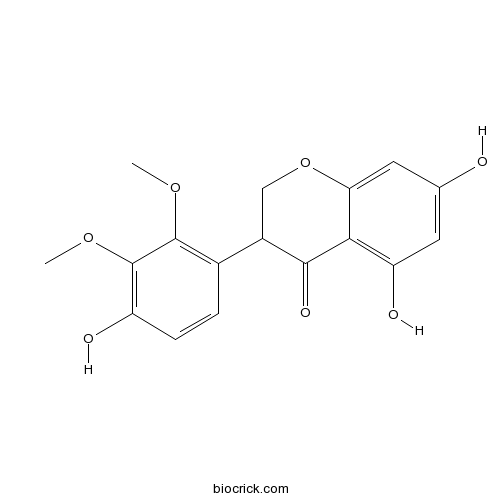ParvisoflavanoneCAS# 49776-79-6 |

Quality Control & MSDS
3D structure
Package In Stock
Number of papers citing our products

| Cas No. | 49776-79-6 | SDF | Download SDF |
| PubChem ID | 44257394 | Appearance | Powder |
| Formula | C17H16O7 | M.Wt | 332.3 |
| Type of Compound | Flavonoids | Storage | Desiccate at -20°C |
| Solubility | Soluble in Chloroform,Dichloromethane,Ethyl Acetate,DMSO,Acetone,etc. | ||
| Chemical Name | 5,7-dihydroxy-3-(4-hydroxy-2,3-dimethoxyphenyl)-2,3-dihydrochromen-4-one | ||
| SMILES | COC1=C(C=CC(=C1OC)O)C2COC3=CC(=CC(=C3C2=O)O)O | ||
| Standard InChIKey | KPBUWUOWFRHOIU-UHFFFAOYSA-N | ||
| Standard InChI | InChI=1S/C17H16O7/c1-22-16-9(3-4-11(19)17(16)23-2)10-7-24-13-6-8(18)5-12(20)14(13)15(10)21/h3-6,10,18-20H,7H2,1-2H3 | ||
| General tips | For obtaining a higher solubility , please warm the tube at 37 ℃ and shake it in the ultrasonic bath for a while.Stock solution can be stored below -20℃ for several months. We recommend that you prepare and use the solution on the same day. However, if the test schedule requires, the stock solutions can be prepared in advance, and the stock solution must be sealed and stored below -20℃. In general, the stock solution can be kept for several months. Before use, we recommend that you leave the vial at room temperature for at least an hour before opening it. |
||
| About Packaging | 1. The packaging of the product may be reversed during transportation, cause the high purity compounds to adhere to the neck or cap of the vial.Take the vail out of its packaging and shake gently until the compounds fall to the bottom of the vial. 2. For liquid products, please centrifuge at 500xg to gather the liquid to the bottom of the vial. 3. Try to avoid loss or contamination during the experiment. |
||
| Shipping Condition | Packaging according to customer requirements(5mg, 10mg, 20mg and more). Ship via FedEx, DHL, UPS, EMS or other couriers with RT, or blue ice upon request. | ||
| Description | 1. α-glucosidase inhibitors |

Parvisoflavanone Dilution Calculator

Parvisoflavanone Molarity Calculator
| 1 mg | 5 mg | 10 mg | 20 mg | 25 mg | |
| 1 mM | 3.0093 mL | 15.0466 mL | 30.0933 mL | 60.1866 mL | 75.2332 mL |
| 5 mM | 0.6019 mL | 3.0093 mL | 6.0187 mL | 12.0373 mL | 15.0466 mL |
| 10 mM | 0.3009 mL | 1.5047 mL | 3.0093 mL | 6.0187 mL | 7.5233 mL |
| 50 mM | 0.0602 mL | 0.3009 mL | 0.6019 mL | 1.2037 mL | 1.5047 mL |
| 100 mM | 0.0301 mL | 0.1505 mL | 0.3009 mL | 0.6019 mL | 0.7523 mL |
| * Note: If you are in the process of experiment, it's necessary to make the dilution ratios of the samples. The dilution data above is only for reference. Normally, it's can get a better solubility within lower of Concentrations. | |||||

Calcutta University

University of Minnesota

University of Maryland School of Medicine

University of Illinois at Chicago

The Ohio State University

University of Zurich

Harvard University

Colorado State University

Auburn University

Yale University

Worcester Polytechnic Institute

Washington State University

Stanford University

University of Leipzig

Universidade da Beira Interior

The Institute of Cancer Research

Heidelberg University

University of Amsterdam

University of Auckland

TsingHua University

The University of Michigan

Miami University

DRURY University

Jilin University

Fudan University

Wuhan University

Sun Yat-sen University

Universite de Paris

Deemed University

Auckland University

The University of Tokyo

Korea University
- Aromadendrene
Catalog No.:BCN8663
CAS No.:489-39-4
- Angelicide
Catalog No.:BCN8662
CAS No.:92935-94-9
- Glicoricone
Catalog No.:BCN8661
CAS No.:161099-37-2
- Bacopaside I
Catalog No.:BCN8660
CAS No.:382148-47-2
- Vinaginsenoside R4
Catalog No.:BCN8659
CAS No.:156009-80-2
- Nuezhenidic acid
Catalog No.:BCN8658
CAS No.:183238-67-7
- Kanzonol C
Catalog No.:BCN8657
CAS No.:151135-82-9
- Ginsenoside Rh7
Catalog No.:BCN8656
CAS No.:343780-68-7
- 5-Ethoxy-10-Gingerol
Catalog No.:BCN8655
CAS No.:121771-98-0
- Angelicolide
Catalog No.:BCN8654
CAS No.:90826-58-7
- 11alpha-Methoxysaikosaponin F
Catalog No.:BCN8653
CAS No.:104109-37-7
- Daidzein diacetate
Catalog No.:BCN8652
CAS No.:3682-01-7
- Lappaol F
Catalog No.:BCN8665
CAS No.:69394-17-8
- 4''-methyloxy-Daidzin
Catalog No.:BCN8667
CAS No.:1195968-02-5
- 4''-methyloxy-Genistin
Catalog No.:BCN8668
CAS No.:950910-16-4
- Ophiopogonanone B
Catalog No.:BCN8669
CAS No.:1316759-83-7
- Moscatin
Catalog No.:BCN8670
CAS No.:108335-06-4
- Epimagnolin B
Catalog No.:BCN8671
CAS No.:1134188-26-3
- Resveratroloside
Catalog No.:BCN8672
CAS No.:38963-95-0
- Pomiferin
Catalog No.:BCN8673
CAS No.:572-03-2
- Aurantio-obtusin beta-D-glucoside
Catalog No.:BCN8674
CAS No.:129025-96-3
- 13-Methylberberine
Catalog No.:BCN8675
CAS No.:54260-72-9
- Lappaol C
Catalog No.:BCN8676
CAS No.:64855-00-1
- Magnaldehyde B
Catalog No.:BCN8677
CAS No.:92829-72-6
alpha-Glucosidase inhibitory activities of isoflavanones, isoflavones, and pterocarpans from Mucuna pruriens.[Pubmed:24782227]
Planta Med. 2014 May;80(7):604-8.
Three new isoflavanones (1-3) and thirteen known compounds (4-16) were isolated from the roots of Mucuna pruriens. The absolute configurations of isoflavanones 1-3 and Parvisoflavanone (4), lespedeol C (5), and uncinanone C (6) were addressed by a circular dichroism technique. Isoflavanones, isoflavones, and pterocarpans of M. pruriens were found to be alpha-glucosidase inhibitors. Medicarpin (7) and parvisoflavone B (9) were potent alpha-glucosidase inhibitors (twofold less active than the standard drug acarbose). The production of bioactive metabolites in M. pruriens seems to be season-dependent.


